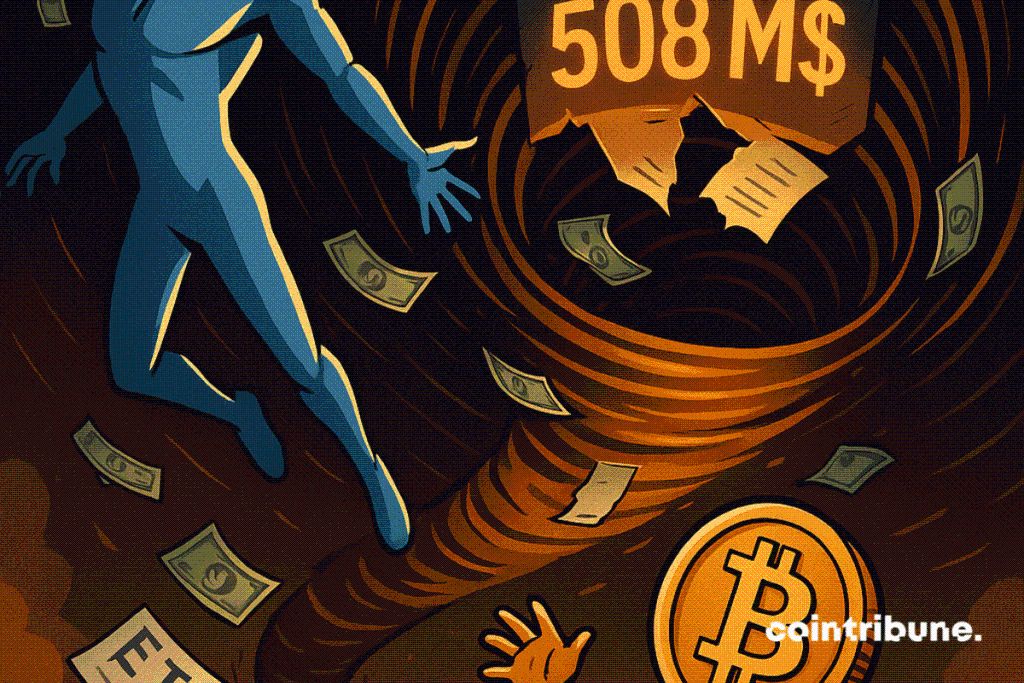Institutional Investors Turn Their Backs on Bitcoin and Ethereum
In one week, spot ETFs backed by ether (ETH) saw about $508M in withdrawals, while Bitcoin ETFs also recorded notable outflows. The movement is not trivial. It reflects market sentiment, risk management arbitrage, and how institutional investors are now recalibrating their exposure to crypto assets.

In Brief
- Ethereum spot ETFs register $508M outflows, while Bitcoin also sees withdrawals
- The movement reflects institutional rotation: beta reduction, ETH/BTC arbitrage and more tactical risk management
- In the short term, these flows weigh on spot but create entry windows, to be monitored via basis/funding.
$508M Exits from Ethereum and Bitcoin ETFs, Sign of Arbitrage and Tactical Caution
A spot ETF is not just a market note: it captures real flows, backed by reserves of underlying assets. As JPMorgan points out, client interest in spot Bitcoin ETFs is intensifying, signaling a redeployment of demand towards spot exposure. When investors lighten up, the issuer mechanically reduces its positions in ether or bitcoin. Result: capital contracts on one side, reinjects on the other, and liquidity reorganizes at the pace of institutional arbitrage.
The fact that Ethereum and Bitcoin record simultaneous outflows suggests a collective move. No panic. Rather a quick normalization of risk. Traders reduce, take profits, lighten the delta. In short, they become tactical again.
ETF withdrawals can temporarily weigh on the spot price. Not systematically: it all depends on order book depth and hedges already in place via futures and options. But, marginally, these flows matter and accelerate internal rotations between assets, including between ether and bitcoin.
Institutional Caution: Defensive Tactic or Assumed Rotation?
Analysts see it as short-term caution. That is consistent. When macro visibility becomes murky, the reflex is to reduce beta exposure, keep higher conviction positions. The ETF becomes the ideal control. One click, one allocation moves.
But one should not confuse withdrawals with disenchantment. An ETF outflow may be only the visible leg of a broader strategy: taking profit on spot, reopening via derivatives, buying options in the distribution tail. In other words, closing with one hand, re-encoding risk with the other. It’s clean, efficient, measurable.
Moreover, the ETH/BTC relationship remains central. When the market anticipates a phase of bitcoin dominance (narrative “digital reserve”, deeper institutional demand), it is logical to see arbitrage disadvantaging ETH in the short term. Then, often, the balance rebalances when approaching catalysts specific to the Ethereum ecosystem. Patience and granularity.
Market Consequences
Massive withdrawals concentrated over a few sessions can thin out order books. This creates “price gaps.” For a patient operator, these gaps are entry windows. Not in all-in mode. In ladder mode. Step by step. With smart stops and adjusted sizes.
The basis/funding spread between spot and derivatives: outflows from ETFs, combined with easing funding, signal selling pressure being absorbed. If the basis remains positive but more measured, the market catches its breath.
Disclaimer: The content of this article solely reflects the author's opinion and does not represent the platform in any capacity. This article is not intended to serve as a reference for making investment decisions.
You may also like
The former legendary project ORE returns: new economic model launched, surging over 30 times in a single month
Solana co-founder Toly retweeted a post to highlight the advantages of ORE, including continuous miner incentives, staking rewards coming from protocol revenue rather than inflation, and fees being fed back into the ecosystem.

The Trillion-Dollar Battle: Musk vs. Ethereum, Who Should Win?
It is not a contest between "personal heroism" and "technical protocols", but a competition between "equity option returns" and "network adoption rate".

US Government Shutdown Ends + Cash Handouts, Will Crypto See a Liquidity Boom?
According to Polymarket data, the market estimates a 55% probability that the U.S. government shutdown will end between November 12 and 15.

The once-mythical ORE makes a comeback, surging 30 times in a single month this time
The mining protocol that caused congestion on the Solana network has returned to the stage with a brand new economic model after a year of silence.

